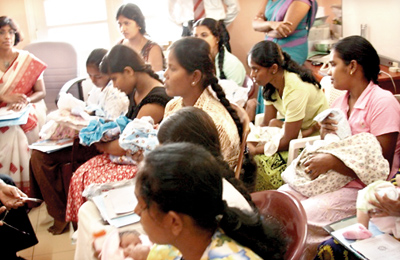Bring back a smile to their faces
Cleft Lip and Palate is a condition that may not be life-threatening but young lives would be full of surgery, therapy, frustration, and even exclusion. That’s the general perception of Cleft Lip and Palate -a congenital disorder (a condition existing at birth and often before birth) that causes a facial deformity of a newborn.

“That perception is not always right,” says Consultant Orthodontist, Dr. Sriyani Basnayake. “True, such children have to undergo surgery and therapy very early in their lives, but by no means should they be excluded from society.”
We have all encountered parents who hide their child, affected by a cleft lip, out of the fear of marginalisation, but Dr. Basnayake points out that Cleft Lip and Palate is treatable. “We have one of the best treatment facilities here, and the stigma surrounding the disease should be eradicated,” she says.
What is a Cleft Lip and Palate?
A cleft lip is a split in the upper lip, which can range from a notch in the coloured part of the upper lip to a complete separation in one or both sides of the lip, extending up to the nose. While a cleft palate is a split in the roof of the mouth, cleft lip and palate can occur separately or together. Generally, bone and tissue from both sides of the face and palate grow and join in the middle and form the lip and palate – the failure of this union is what results in the cleft lip and cleft palate. “The cause is not really understood. About 5 per cent of the cases can be put down to heredity but the rest is largely unknown,” says Dr. Basnayake.
Problems associated with Cleft Lip and Palate
The major concern with having a baby with cleft lip and cleft palate is the difficulty in feeding. Usually when babies feed, the tongue creates a vacuum inside the mouth by sealing the lips around the nipple or teat, but babies with clefts may not be able to do this efficiently; thus needing external help.
“Mostly cases are reported from the lower socio-economic classes. It is hard to breast-feed, and sometimes the mother doesn’t produce enough milk,” Dr. Basnayake says. “The alternative is infant formula milk, but that is too expensive. We encourage mothers to breastfeed the baby or feed expressed breast milk using a special bottle.”
There may also be a difficulty in articulating words, as the soft palate is involved to a large extent in speech. Children with cleft lip and palates can also be subjected to hearing difficulties due to collection of excess fluid in the middle ear leading to the ‘glue ear’ condition. Hearing difficulties can in turn affect learning and speech.
Treatment
“Caring for a baby with cleft lip and palate is a team approach”, says Dr. Basnayake. A cleft team includes: The Paediatrician responsible for the well being of the baby, Plastic Surgeon who is responsible for the surgical repair, Orthodontists and Facio-Maxillary Surgeons who take care of the problems related to teeth, gum and jaws, the Otolaryngologist to look after the problems related to hearing, the Speech and Language Therapist who plays a significant role in the speech development of the child, the Clinical Genetist who counsels the parents with regards to having further children, Psychologists and Social workers who help the parents cope up with the inevitable stress involved.

How to bottle-feed a baby with Cleft Lip and Palate
“At our clinics held once every week, we ensure that the whole team is available to lend assistance to the parents,” says Dr. Basnayake.
At the very first session, parents are taught how to feed their babies, and also receive counselling. There’s a forum where experiences are shared with parents who have had children with Cleft Lip and Palate-but have now overcome it through proper surgery. “It is important that they share the experience, so that parents with such children are given a reassurance that it is treatable,” she adds. “Once they see operated babies doing fine, the smile creeps back into their faces.”
Surgical repair of the lip is done at the age of 3-5 months, while the repair of the palate between the ages of 9-12 months. There may be differences in the amount of change depending on the differing deficiencies of the tissue, but the treatment is a hundred per cent successful.
While it maybe stressful for the parents initially, Dr. Basnayake says that children with cleft lip and palate are normal and their intelligence is not affected by the cleft. “The difference in appearance, voice and speech may leave the child feeling challenged, but education on the deformity can help the child understand, while they should be constantly encouraged to be independent and mix freely with the others,” she says, adding that strong emotional support needs to be given by the parents.
“Having a child with cleft lip and palate is not something to be ashamed of. It is caused by multi-factorial reasons and is well beyond the control of parents. It cannot be prevented, but what is important is that the children are brought to the clinics as soon as possible,” she stresses.
Follow @timesonlinelk
comments powered by Disqus


